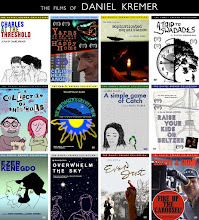I have just returned from a venture out to San Francisco where I shot a new feature film, this time as co-director next to my friend Deniz Demirer, who is also currently editing a very exciting feature film called American Mongrel, due for release this year. Our new collaborative feature is titled Ezer Kenegdo, and it is certainly a work of an extremely personal nature for both of us. Truth be told, it is perhaps the most personal and most close-to-the-breast film I have yet made, as it explores and probes issues that have long been the subject of much intense meditation for me. I think my collaborator would say the same. The shooting of the film is something I have recently been fond of calling "Movie Camp," in that the experience of making it re-invigorated me and revitalized my filmmaking drive after it had been dampened by a prodigiously difficult and stressful production this past summer in Sag Harbor, Long Island.
Deniz often works as an actor and editor for local Bay Area filmmaking legend Rob Nilsson, who recently published two articles on the ConFluence-Film Blog as a guest writer. I got to spend some time with Rob, who will appear in a key supporting role in Ezer Kenegdo, and shared one particularly rewarding and engaging conversation of length with him. We discussed mutual friends we shared, the dying art of making work that is true and good and worthwhile, our excitement for our upcoming projects and a variety of other things.
While out in the Bay Area, I got my hands on a number of excellent films that I felt compelled to write something about. So here it goes...
Nocturnal Jake (2009, Deniz Demirer) - Deniz prefaced his originally reticent screening of this film for me by referring to it as "an exorcism," which immediately turned my head. On first attempt of viewing the film, I was so fatigued from a full day of shooting and schlepping for Ezer Kenegdo that I fell asleep somewhere in the middle. Deniz, however, continued watching on his own, and reported back to me the next day how rewarding it was to see it again after a time of essentially half-burying it. I informed him that, allegiances and friendship aside, I was absolutely entranced by the half that I saw, and that I had literally been fighting the tremendous weight of my eyelids the previous night, out of sheer old-fashioned exhaustion. I later finished the entire film solo back home in New York, and I must say that if I were to return to re-compose my Best of 2009 list, Nocturnal Jake would certainly have found a place in the Top 10.
As much as I would seem to admire the film, Nocturnal Jake is not an easy film to describe, and it would be foolhardy and half-hearted of me to attempt to do so. Some films defy a reviewer's routine impulse to recount filmic event, by sheer virtue of the fact that the work in question is more of an experience to be had rather than simply a collection of scenes. Nocturnal Jake boldly creates its own language, and immerses the audience in that storytelling language so that, by the time the deliciously enigmatic end rolls around, a thoughtful and intelligent viewer not just understands the language but will also find it challenging when attempting to indulge in watching a more traditional work. After a film like this, you are spoiled by sheer originality. Everything comes together, from the moody jazz music score, to its custom-made narrative voice, to its take-it-to-the-streets camerawork, and of course the performances, particularly that of lead actor, real-life jazz musician David Boyce. Boyce recalls the quiet intensity of Dexter Gordon's tortured sax player in Bertrand Tavernier's 'Round Midnight. The film also fuses so many forms so effectively that it leaves a viewer enrapt in the experience, and thankfully breathless.
Last week, a friend of mine informed me about a L.A. Rebellion Movement film retrospective in Philadelphia, and informed me that Larry Clark's Passing Through (1977), the story of a jazz saxaphonist, was screened, along with Clark's previous featurette As Above So Below (1973). I have seen neither film, but cannot imagine Passing Through being any better or more poetic with its form than Nocturnal Jake. I have a natural soft-spot for impassioned grass-roots features. Nocturnal Jake is also infused with the impetuous, irresistible "first-time filmmaker" spirit — that highly charged, almost tangible energy — that made debut works like Shadows shine through the dross that's all dressed up with nowhere to go. Seeing a film like Nocturnal Jake exposes this dross for what it is: invalid and worthless when compared to a film of its like.
Over-Under Sideways-Down (1976, Eugene Corr, Peter Gessner and Steve Wax) - This is the classic example of an unjustly buried film that has long been missing-in-action. I myself learned about it only through having read a particular piece some time ago about Nilsson's Cannes Camera d'Or winning debut feature Northern Lights (1979), which was produced by a "Marxist-light" independent filmmaking group called Cine Manifest. While Northern Lights developed more of a name and reputation, Cine Manifest's first feature film Over-Under Sideways-Down never quite made its spot in any kind of limelight, other than a one-off showing on a public television independent film series called "Visions" in 1977. I asked Rob Nilsson, when first formally put into e-mail contact with him a little over a year ago, about how one could get a copy of that particular film. Upon meeting him in the flesh just recently, Rob gave me filmmaker Eugene Corr's contact information and told me to get in touch with him. Corr returned my inquiry quite promptly, informing me that "other than a single screening a couple years ago at Anthology Film Archives, the film has been unseen for 35 years or so."
In the e-mail, he continued, "My old video tape copies of it deteriorated to the point of being unwatchable. My intention is to make a DVD from the 16mm sometime in 2013. Steve Wax in NYC says he has the internegative somewhere in storage but I don't think that's definite. In any case, thanks for the interest." Then, in the very same e-mail, mind you, in a post-scriptum, he informed me that he did indeed locate a DVD copy from what he claimed was a substandard videotape recording, which he offered to me. I enthusiastically took him up on the offer and arranged to pick it up from him the next day. I excitedly plopped it into the DVD player as soon as I returned to my co-director Deniz's house, just for a taste-test. Deniz and I were rather immediately entranced by the brilliant economy of the film, in that it was succinct both narratively and visually, and also poetic in its efficiency. Quite honestly, it is a film that knows exactly what it wants to say and what it wants to do, with no namby-pampy sidelining of what is at its center.Wisely and quite fluently recalling the British "angry young man dramas" of the late 50's and early 60's (especially Richardson's Look Back in Anger, Reisz's Saturday Night and Sunday Morning and Clayton's Room at the Top), Over-Under Sideways-Down tells the story of a working-class couple, Roy and Jan, who live with their two children in a cramped tract home. An assembly line worker in a steel plant with developing racial tensions, Roy entertains the escapist fantasy of moving from the local semi-pro baseball team for which he plays third base, to the big leagues. I was likewise reminded of the homegrown indie work Eagle Pennell, as well as two other films, one being No Pets (1994) by Tony Buba, a native of my hometown Pittsburgh who makes films about the Pittsburgh experience, and the other being Sundance-winning friend Paul Harrill's ITVS short film Quick Feet Soft Hands (2008). Incidentally, I sent Paul a copy of Over-Under after he expressed active interest in seeing it. I hope he likewise shares the wealth.
Corr should not have to scrounge for a new print of Over-Under Sideways-Down. This is the type of film that someone should be spending money to restore and preserve. The government with an endowment, perhaps? I might be naive here. Why am I worried about this statement being construed as naivete? That's sad...
I often feel that one of the duties for which I've been put on this Earth is to locate, excavate and circulate films like Nocturnal Jake, Over-Under Sideways-Down, and other wrongly neglected and unseen works that have fallen into the cracks of obscurity. When I embarked on my India-lensed feature The Idiotmaker's Gravity Tour a few years ago now, it was likewise a little film called Montreal Main (1974) by Frank Vitale that gave me the energy to move forward with an all-stops-out feature-length DIY undertaking. Over-Under provided Deniz and myself with an extra tank of gas to move forward with Ezer Kenegdo. Nocturnal Jake gave me the faith that the co-director is a consummate artist with whom I'm honored to be collaborating. That is what works like this have done for me, and this is what they can do for other filmmakers...others, that is, willing to dig up such priceless artifacts awaiting rediscovery.
Next up, I review Rob Nilsson's Chalk and What Happened Here. To be continued...












